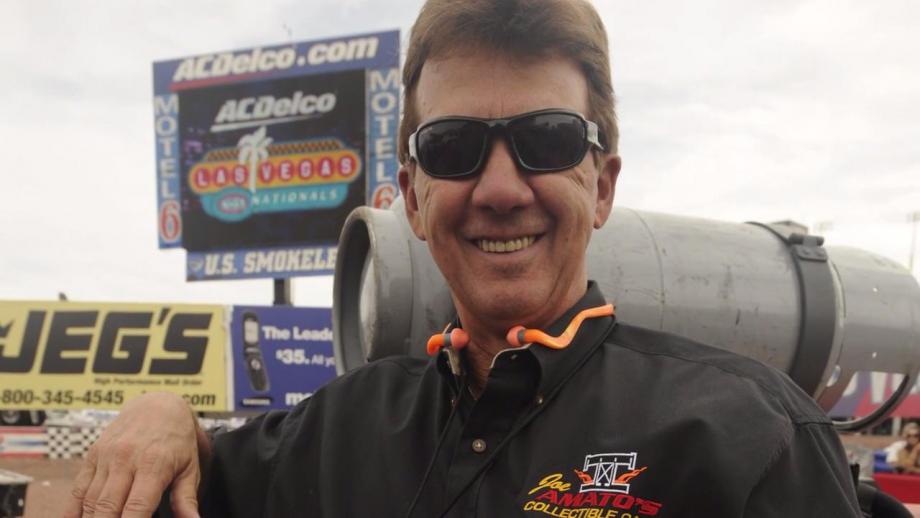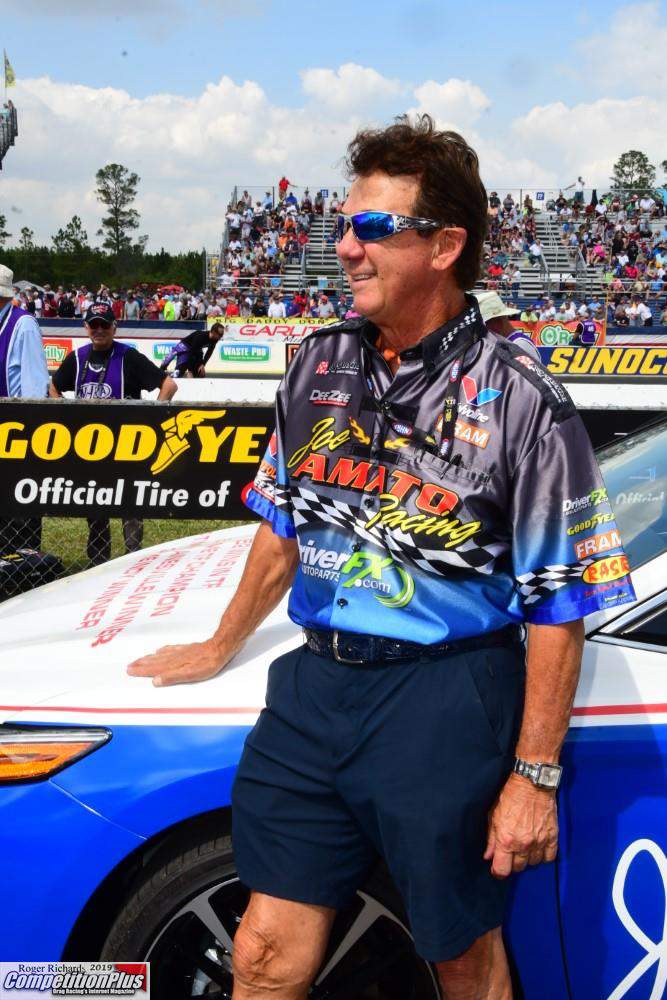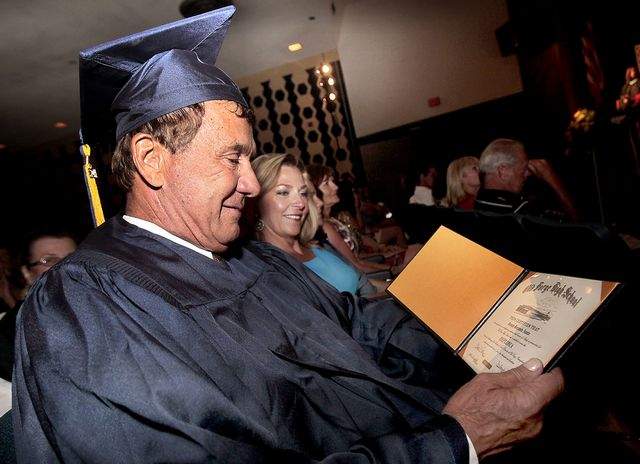LIFE AFTER NITRO: JOE AMATO LIVES LIFE TO THE FULLEST
 It’s pretty simple to sum up Joe Amato: He’s a man who’s done everything he set out to do, whether by necessity or by choice.
It’s pretty simple to sum up Joe Amato: He’s a man who’s done everything he set out to do, whether by necessity or by choice.
He began working in his father’s Pennsylvania speed shop starting at age 11. At 16, he dropped out of school to take over the business, and eventually turned it into an auto parts empire. At one point, five championships and 52 victories made him the winningest Top Fuel driver in NHRA history. And now, in retirement, he’s an experienced traveler who in 2021 anticipates completing visits to all seven of the continents on Earth.
In 1998, Amato sold the business that he, his brother and two partners built and retired from everything but racing and traveling.
“My goal was to retire at 60,” Amato said last week from his home in West Palm Beach, Fla. “But I got lucky and was able to cash out at 54.”
Amato was still hot and heavy into his racing career at that point. A couple of eye injuries convinced him to retire from the driver’s seat in 2000, and he spent the next five years fielding Top Fuel rides for Darrell Russell and Morgan Lucas before folding the team.
After he closed down the racing operation and without Keystone to run, Amato said that he “was kind of bored.” That’s when he began investing in commercial real estate ventures.
“When I sold the business I had some cash,” he said. “I bought an old shopping center that was beat up, got it remodeled, then got it rented, then I bought another one. That’s what I started playing with, and it was more playing than working. I hired some real good people. I’ve got a real good girl that’s kind of been with me since we started this. She’s really smart and thinks like I think, so we ended up buying three, four, five shopping centers up in Pennsylvania and fixing them up.
“I did some housing stuff; condo and townhouse development, just playing around with stuff. I had a good partner in the housing stuff. They do the business, and I help them with the money. We’ve been invested in stuff I can control instead of being heavy in the stock market because you can’t control that.”
Amato, who will turn 76 in mid-June, keeps a home in Moosic, Pa., as well as a house at Harveys Lake, which is about 40 minutes away and is meant for good times with friends and family on boats, jet skis, and a nearby golf course. He has four grown stepchildren, and he’s been with his current wife, Andrea, for the past 16 years.
When he returns to Pennsylvania once coronavirus concerns have abated, Amato will plant tomatoes and zucchini. He’ll enjoy playing with some of his late-model muscle cars that pique his interest. Those toys, of course, can produce hair-raising power.
Among the current fleet is a Dodge Challenger SRT Hellcat Redeye, a car that off the showroom floor can cover the quarter-mile in 10.8 seconds at over 131 mph. He won a celebrity drag race in Las Vegas in a Challenger, and he donated the $10,000 winner’s prize to the Nicklaus Children’s Hospital network.
Amato said he will soon have the keys to a new 767-horsepower Mustang Shelby GT500, and he said he ordered it “because I’ve never had a Mustang like this.” He also owns a red Dodge Demon -- an 840-horsepower beast -- that’s only got 12 miles on it.
 Compared to the horsepower his 300-mph-plus Top Fuel dragsters made, that’s not saying much. But dollar for dollar, he’ll take Detroit muscle over foreign sports cars every time for the simplest of reasons: economics.
Compared to the horsepower his 300-mph-plus Top Fuel dragsters made, that’s not saying much. But dollar for dollar, he’ll take Detroit muscle over foreign sports cars every time for the simplest of reasons: economics.
“For the price, you’re buying a real good car for under $100,000,” he said. “You can drive it for a year and not lose your butt” in resale value.
“It’s not like buying a Ferrari for three or four hundred thousand and you lose a hundred the first year. The American muscle cars -- the Hellcats, Mustangs, the new Corvettes -- there’s so much good stuff out there. They’re not real cheap, but they’re not stupid expensive like the foreign cars.”
Amato has literally been next to, if not in the center of, speed his entire life.
When his father developed heart trouble, Amato helped run the family business, and eventually took over its operation. Soon, Keystone Automotive Warehouse was in existence, with some two dozen outlets before its sale. From a ‘53 Ford for his first car, Amato was soon dabbling in drag racing, and he won five NHRA national events in the Pro Comp ranks in a ride that would now be classified as Top Alcohol Dragster.
In 1982, he and crew chief Tim Richards made the move up to Top Fuel eliminator, and Amato finished in the top 10 in points every year he raced. He captured championships with Richards calling the shots in 1984, ‘88, ‘90 and ‘91, and was still in the hunt for a fifth crown in ‘92 when they had a falling out that Amato still regrets.
“We had a disagreement, which is one of the bigger mistakes of my life,” Amato confessed. “Tim was going through a divorce, and I couldn’t understand where his mind was and we had a parting of the ways. His mind was on divorce and mine was on racing, and they didn’t go together, so he left.
“He made my career in racing, I have to say that. I was able to put the money together, but you still need a good car and he gave me that, from alcohol to Top Fuel.”
They won at Brainerd to take the ‘92 points lead into the U.S. Nationals, and Amato left that event with the upper hand -- but without Richards. Kenny Bernstein took the points lead after the next stop, at Reading, as Amato adapted on the fly in the midst of a title hunt.
Another driver and crew chief -- Doug Herbert and Jim Brissette, respectively -- came to the rescue. After Reading, the tour headed to Topeka, where Amato reclaimed the lead and never relinquished it.
“We made our car identical to their car, every jet, every nut, every bolt, clutch,” Amato said, “and they helped me using my crew guys -- Jeff Rogers, Jim Walsh, the guys that I had working for me. They kind of tuned the car with the help of Herbert and his guys, and they helped us win the championship. … Tim got me to the lead at Indy and then we were able to pull it off.
“I remember Bernstein was right there behind us, and I think he thought they would be able to beat us -- and they almost did. He wasn’t real happy. You think you’re going to win something and it doesn’t work. I was lucky and the people fell into place.”
Bernstein, in fact, slipped to third in the final standings with Cory McClenathan elbowing his way into second behind the now-five-time champ.
Later that decade, Amato, his brother and their partners faced the decision to either invest a lot more time and money into Keystone “to take it to another level” or look for a buyer. They opted for the latter.
“We all just thought that if we could find the right amount of people to buy the thing, take it off the table and give us some money, we could go do what we want to do while we’re still young enough,” Amato said. “When you can retire in your 50s, that’s pretty good. I was racing and doing other stuff and everybody else was doing a little bit of other stuff, and we all thought, ‘If we get the money, let’s take the money and run’ -- and we did.”
Fortunately, Amato Racing was still operating at full speed, which helped ease the transition for the owner/driver. Then in 1999 came the first of two eye injuries that would accelerate the end of his career as a Top Fuel driver.
“I was wearing contact lenses when I was driving at night for better vision. A couple of times, the contact lenses ended up in the back of my eyeball and I couldn’t get ‘em out. I saw floaters and knew something just wasn’t right,” he said. “So we get home and I called my local eye doctor. He looks at my eye and says, ‘You tore the membrane over your eye, we’ve got to laser it shut.’ So they lasered it, and he said I couldn’t race for two weeks. I think Gary Beck drove the car for the one race.”
RELATED STORY - AMATO GETS HIS DIPLOMA

In an attempt to reduce the chance of a recurrence, Amato changed his stopping procedure to lessen the negative G-forces at the end of the run. Instead of deploying the parachute first as he’d done throughout his career, Amato said he first scrubbed off some speed with the brakes before he unleashed the chutes.
Even at that, he tore the membrane again and had to have it repaired.
“I decided at that point in time that I could detach the retina and maybe lose my vision in that eye. They might be able to fix it, they might not,” he said. “I was going to retire the next year anyway -- a tour; I was already working on hats and shirts and all that baloney -- so I went ahead and got out” at the end of the 2000 tour.
“I wanted to try being a team owner to see if I enjoyed it. Other guys did it, so I said, ‘Let me try, I’ve got all the stuff,’” said Amato, who was a national-event finalist in Top Fuel 99 times. “It was OK, it was nice. You’re still out there, but when you’re used to driving the car, it’s a whole different animal when you’re standing on the sidelines and somebody else is driving it. It’s not quite the same when you’re the team owner and not the driver.
“It was all about the competition, going to the line and being able to leave on the guy in the other lane and beat ‘em. Like (Don) Prudhomme always said, you want to rip the heart out of the competition. That’s the thrill of it. The money is nice to win, but I was more motivated by the excitement of the competition. You’ve got to be able to perform, and lucky enough, we had the right team and the general, Tim Richards.”
Hired to replace Amato behind the wheel was a young Top Alcohol Dragster pilot out of Texas, Darrell Russell, a driver Amato hired after a phone conversation.
“Somebody brought Darrell’s name up, that he was driving alcohol, a nice young man, clean-cut and steady. … I talked to him on the phone and he seemed like he was the right guy and we hired him. He definitely was the right guy, he performed well, we won with him,” Amato said.
In fact, Russell won his Top Fuel debut in the NHRA Winternationals at Pomona, Calif. He also won the NHRA Springnationals in Columbus, Ohio, on Amato’s 60th anniversary, which Amato rates as one of his favorite racing memories.
“He was a good guy, a class guy, Darrell was,” he said.
Amato’s voice softened as he discussed Russell, especially with regards to the driver’s death in a race at Madison, Ill., in mid-2004. Problems with Goodyear’s new rear tire concerned Amato so much that he procured a batch of the prior version in the belief that it was a proven, safer alternative. NHRA, Amato said, wouldn’t permit his team to use those older-model tires, despite he and Russell pleading their case -- to no avail -- prior to that fateful race near St. Louis.
“I said, ‘Is it going to take somebody dying before we change this tire?’ ” Amato said.
“And the next friggin’ race, my guy dies.”
Devastated, but vowing to plow ahead, Amato hired Morgan Lucas to finish out the 1994 season, and he stuck with the young driver for the team’s final year, 1995.
“The kid did good,” Amato said of Lucas. “He jumped right in and did good.”
Amato said he missed racing once he exited the stage, “but I did a lot, accomplished a lot, and I had a good time. I had a good run.
“The basement of my house in Pennsylvania is like a museum, I have every trophy, every helmet I ever raced with, probably a thousand pictures, a hundred posters -- the whole basement is just memorabilia stuff; rings, all the stuff we won. It’s a pretty cool set-up, I’ve got to say. The trouble is I’m trying to figure out what to do when I die, right?”
Amato has remained an aficionado of the sport. He said he watches “all the races,” and is especially attentive to drivers’ reaction times and the points race.
“I definitely pay attention. I look at NHRA.com. I like the new president (Glenn Cromwell), I think he’s very good for them,” he said.
As for his favorite drivers, Amato paused briefly before answering, “The ones that’re winning.”
 When he’s not working in his garden or enjoying the good life on the lake in Pennsylvania or his home on the Intracoastal Waterway in West Palm Beach, Fla., Joe Amato and his wife relish traveling the globe together. They’re clients of Exclusive Resorts, a luxury-resort travel club whose initial membership premium is $150,000. And for their money, they’ve gotten to see the world in ways few others can enjoy.
When he’s not working in his garden or enjoying the good life on the lake in Pennsylvania or his home on the Intracoastal Waterway in West Palm Beach, Fla., Joe Amato and his wife relish traveling the globe together. They’re clients of Exclusive Resorts, a luxury-resort travel club whose initial membership premium is $150,000. And for their money, they’ve gotten to see the world in ways few others can enjoy.
“We have 85 days a year that we’re somewhere in the world, so we spend a lot of time on the road,” he said.
“We go to Italy a lot -- Tuscany, Florence -- and we go to Paris a lot. We go skiing twice a year, usually somewhere in Colorado,” he said. “You’ll get a three- or four-bedroom house, so you bring your friends. Places in the Caribbean.”
A few months ago, Joe and Andrea Amato were on an around-the-world venture when President Donald Trump announced coronovirus-related travel restrictions that would put a halt to flights coming into the U.S. from Europe and other countries. That ended their 26-day trip early, but he said they got back to America in time to beat the deadline to return.
“It was 50 people in a big jet, all first class. We left Washington, D.C., and went to Peru for two days, then we went here, went there … insane, all the places we went,” Joe said.
“We landed in India on a Friday night, and we heard about them closing the borders. We two people from Mexico out of the 50 and four that were Canadians, and they couldn’t go back to the United States with us because they weren’t Americans. So they pulled the plug on the last week, and we didn’t go to Africa and some places we were supposed to. We went to Pennsylvania and quarantined there for a week, then we came back down here to Florida.”
Fortunately, the Amatos had already been to parts of Africa, and that was a trip that left a vivid impression on the former racer.
“You’re in a Jeep, and there’s a lion on the ground about 20 feet away from you,” he said. “You’re driving down the road and a giraffe walks up to you, and you’re eyeball to eyeball with a frickin’ giraffe.
“There’s so much out there in life to go out and see, and I’m so blessed -- very, very blessed -- that at my age that, A, I’m healthy enough to go do it, and, B, that I can afford to do it. I started running my father’s speed shop when I was 11, at 16 I took it over and made it into Keystone Automotive, got lucky and sold it and got a coupla pennies.
“So now I’ve got enough money to go play, and believe me, I’m playing hard.”









































